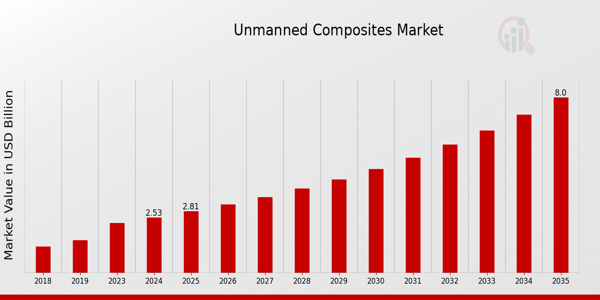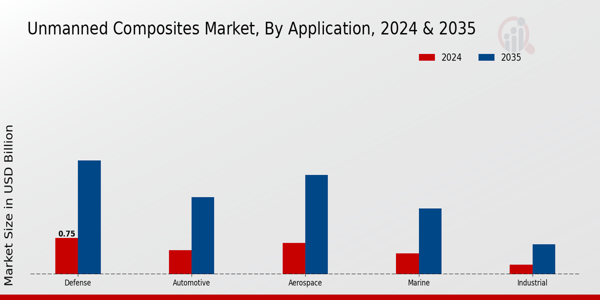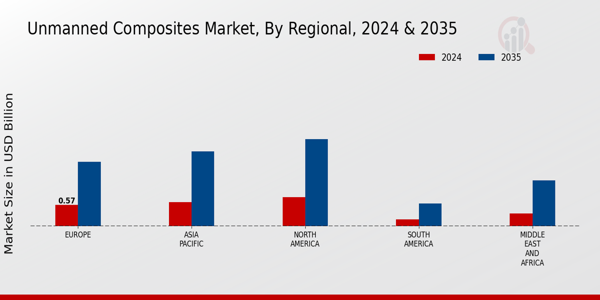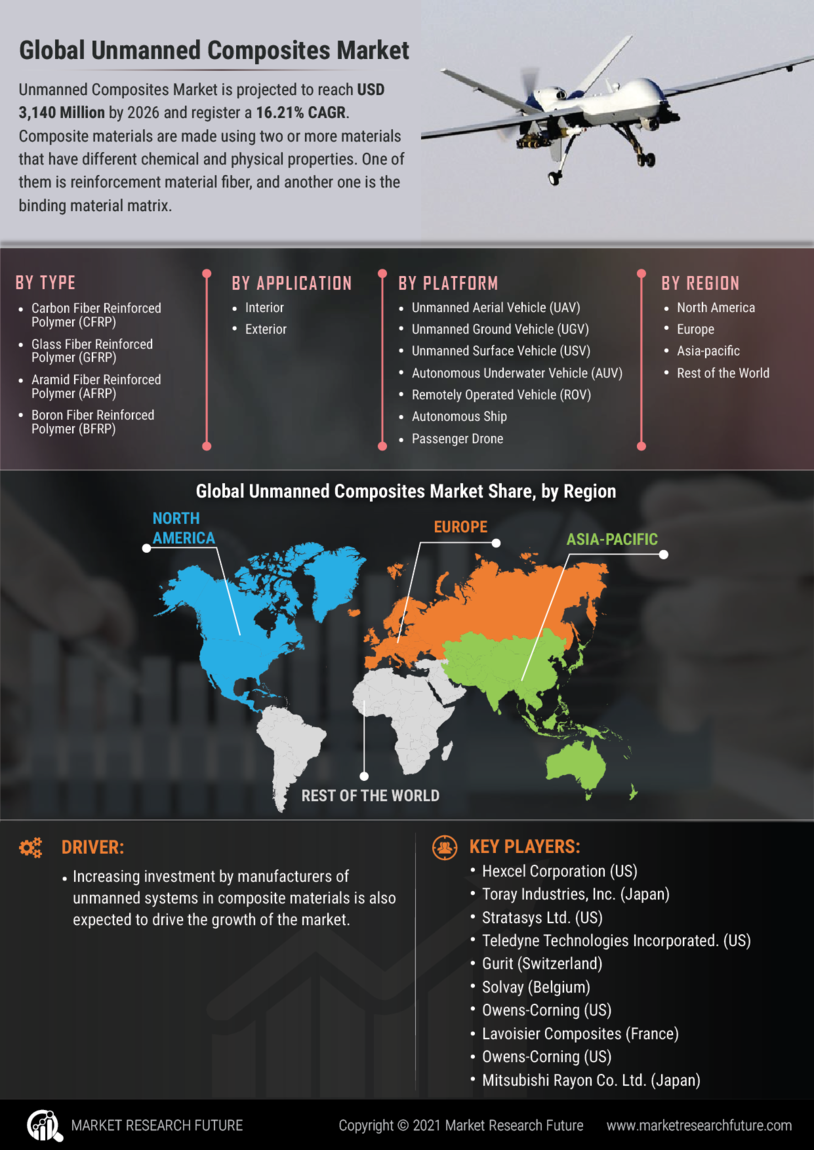Unmanned Composites Market Summary
As per Market Research Future Analysis, the Unmanned Composites Market size was valued at USD 1.42 billion in 2024 and is projected to grow from USD 1.69 billion in 2025 to USD 8.18 billion by 2035, with a CAGR of 17.2% during the forecast period. The growth is driven by the increasing demand for high-performance composite materials in unmanned systems, particularly in the military and defense sectors. Composites like Carbon Fiber Reinforced Polymers (CFRP) are essential for enhancing the performance of unmanned vehicles, offering a superior strength-to-weight ratio, durability, and resistance to environmental challenges. The rise of Urban Air Mobility (UAM) further presents significant opportunities for the market, necessitating advanced materials for efficient and sustainable transportation solutions.
Key Market Trends & Highlights
Key trends influencing the Unmanned Composites Market include technological advancements and increasing applications across various sectors.
- Market Value in 2024: USD 1.42 billion; Projected Growth to USD 8.18 billion by 2035.
- CAGR during 2025-2035: 17.2%; Driven by demand for lightweight and durable materials.
- Dominant Segment in 2024: Carbon Fiber Reinforced Polymer (CFRP); Fastest-growing segment during the forecast period.
- Largest Regional Market in 2024: Asia-Pacific; Expected to maintain rapid growth due to rising investments in unmanned systems.
Market Size & Forecast
2024 Market Size: USD 1.42 billion
2035 Market Size: USD 8.18 billion
CAGR (2025-2035): 17.2%
Largest Regional Market Share in 2024: Asia-Pacific.
Major Players
Key players include Toray Industries, Hexcel Corporation, Teijin Ltd., SGL Group, Materion Corporation, Unitech Aerospace, Carborundum Universal Limited, Carbon by Design, Mitsubishi Chemical Corporation, Syensqo.
Key Unmanned Composites Market Trends Highlighted
The Unmanned Composites Market is experiencing significant trends that are being driven by a variety of factors that are contributing to its growth. The expanding demand for lightweight materials in the aerospace and defense sectors is a substantial market driver. The high strength-to-weight ratios of composites are becoming increasingly coveted, as they improve the overall performance and fuel efficiency of unmanned aerial vehicles (UAVs). Furthermore, manufacturers are increasingly employing environmentally favorable composite materials in response to the growing emphasis on sustainable manufacturing practices.
This demand is additionally reinforced by initiatives that are designed to improve operational efficiencies and decrease carbon emissions.The Unmanned Composites Market is experiencing a surge in opportunities, particularly as industries investigate advanced materials for unmanned systems. The potential for substantial improvements in cost efficiency and design flexibility is presented by advancements in composite manufacturing processes, including automated fiber placement and 3D printing. Additionally, emerging markets are experiencing growth potential as a result of the increased investment in unmanned technology. The incorporation of artificial intelligence and machine learning into unmanned systems has been a prevalent trend in recent years.
This integration is not only improving operational capabilities but also fostering a synergy between smart technology and advanced materials in applications.Moreover, the demand for high-performance composites is on the rise as a result of government initiatives that advocate for the use of unmanned systems in defense and surveillance operations. In general, the convergence of these trends within the Unmanned Composites Market indicates a dynamic evolution, which will facilitate future advancements and market expansion.

Unmanned Composites Market Drivers
Rising Demand for Lightweight Materials
The Unmanned Composites Market Industry is witnessing a significant increase in the demand for lightweight materials, which are essential for enhancing the efficiency of unmanned systems. According to the International Organization for Standardization (ISO), the aerospace sector has seen a shift towards composites due to their weight reduction capabilities, with estimates suggesting that composites can reduce aircraft weight by up to 20 percent compared to traditional materials.This reduction is critical in improving fuel efficiency, which is expected to become crucial as governments around the world aim to achieve carbon neutrality by 2050.
Organizations such as Airbus and Boeing are already investing heavily in composite technologies to remain competitive in this evolving market. The increasing push for reducing carbon emissions in the aviation industry reinforces the need for adopting composites, positively impacting the unmanned composites market.
Advancements in Manufacturing Technologies
Technological advancements in the manufacturing processes of composites, particularly in automation and customization, are propelling the growth of the Unmanned Composites Market Industry. Innovations such as Automated Fiber Placement (AFP) and Additive Manufacturing have been shown to reduce production times by approximately 30 percent while increasing precision in composite component production.
Companies like Hexcel Corporation are adopting these advanced manufacturing techniques to produce composites more efficiently.Furthermore, a report by the European Commission highlighted that advancements in manufacturing technologies could improve production capabilities and lower costs, making composite materials more accessible to companies in various sectors, including defense and aerospace, thus stimulating market growth.
Surge in Military and Defense Expenditure
The Unmanned Composites Market Industry is significantly influenced by the surge in military and defense expenditures observed ly. According to the Stockholm International Peace Research Institute (SIPRI), military spending reached approximately USD 1.98 trillion in recent years, with a notable emphasis on unmanned systems, drones, and associated technologies.
Countries are increasingly investing in advanced defense systems to enhance national security, with nations like the United States, China, and Russia leading in defense budgets dedicated to unmanned technologies.The focus on developing advanced surveillance and reconnaissance capabilities is anticipated to boost the demand for composite materials, as they are ideal for use in military applications due to their lightweight and durable nature.
Unmanned Composites Market Segment Insights:
Unmanned Composites Market Application Insights
The Unmanned Composites Market is witnessing substantial growth across various applications, with high demand for advanced materials in multiple industries. In 2024, the market is poised to emerge with a complete valuation of 2.53 USD billion, signaling the increasing adoption of unmanned systems integrated with composite materials.
The Aerospace application segment holds significant importance in this market, valued at 0.65 USD billion in 2024 and projected to grow to 2.06 USD billion by 2035, driven by the need for lightweight and high-strength materials in aviation, enhancing fuel efficiency and performance.Similarly, the Defense sector is another major contributor, with a value of 0.75 USD billion in 2024, expected to reach 2.36 USD billion in 2035, due to rising defense budgets and the growing emphasis on unmanned aircraft capabilities.
The Automotive segment, valued at 0.5 USD Billion in 2024 and anticipated to grow to 1.6 USD billion by 2035, reflects the increasing integration of composites for enhancing the safety and performance of electric and autonomous vehicles.
In addition, the Marine sector is gaining traction with a market value of 0.43 USD billion in 2024, forecasted to expand to 1.36 USD billion by 2035, largely attributed to the demand for durable lightweight materials in unmanned underwater vehicles for exploration and research purposes.Furthermore, the Industrial application, although smaller, with a valuation of 0.2 USD Billion in 2024 projected to rise to 0.62 USD billion by 2035, indicating an evolving trend in automation and efficiency optimization in manufacturing processes.
The dominant sectors, such as Aerospace and Defense, significantly drive the Unmanned Composites Market industry, as they require continuous innovation and adoption of advanced composite materials to enhance performance, sustainability, and reliability. This growth in demand across the different segments illustrates a trend towards integration of unmanned composites across various applications, positioning the market for long-term growth and expansion opportunities fueled by ongoing technological advancements and strategic initiatives across industries.

Unmanned Composites Market Material Type Insights
The Unmanned Composites Market, valued at 2.53 USD Billion in 2024, is significantly driven by the Material Type segment. This segment encompasses various composites such as Carbon Fiber Composites, Glass Fiber Composites, Aramid Fiber Composites, and Thermoplastic Composites, each with unique properties suited for unmanned applications. Carbon Fiber Composites are known for their high strength-to-weight ratio, making them ideal for weight-sensitive drone applications. On the other hand, Glass Fiber Composites provide a cost-effective and versatile option commonly used in less demanding environments.Aramid Fiber Composites, recognized for their high durability and impact resistance, are essential in applications requiring robustness.
Furthermore, Thermoplastic Composites offer advantages like improved processing speed and recyclability. Market data shows that these materials are becoming increasingly important as industries seek lightweight, durable, and efficient solutions in unmanned technologies. The growth in the Unmanned Composites Market is supported by initiatives aimed at enhancing the performance and sustainability of unmanned systems, presenting substantial opportunities across various sectors.This dynamic landscape highlights the importance of Material Type in the overall market segmentation and showcases the potential for innovation and development in the Unmanned Composites Market industry.
Unmanned Composites Market Manufacturing Process Insights
The Unmanned Composites Market is poised for notable growth, specifically within the Manufacturing Process segment, which is a critical component driving the overall market forward. By 2024, the market is expected to reach a valuation of 2.53 USD billion and grow to 8.0 USD billion by 2035. This segment encompasses various techniques such as Lay-Up Process, Resin Infusion, Pultrusion, and Prepreg Processing, each playing a significant role in contributing to efficiency and performance improvements in composite manufacturing.
The Lay-Up Process is particularly important for its versatility and ease of application, while Resin Infusion offers advantages in producing high-quality composites with reduced voids.Pultrusion serves as a predominant method for creating continuous composite profiles, essential for various applications due to its efficiency and cost-effectiveness. In addition, Prepreg Processing enables manufacturers to produce high-strength composite parts with closely controlled fiber-resin ratios, which are crucial for high-performance applications. The demand for lightweight, durable materials in industries such as aerospace, automotive, and defense further fuels the growth of the Unmanned Composites Market, making this segment vital for innovation and technological advancement.
Unmanned Composites Market End Use Industry Insights
The Unmanned Composites Market size is poised for notable growth, with a valuation of 2.53 billion USD in 2024 and projected to reach 8.0 billion USD by 2035. The market is driven by increasing demand for lightweight and durable materials, particularly in key End Use Industries such as Commercial Aviation, Military, Automotive, and Robotics. The Commercial Aviation sector has been leveraging advancements in unmanned technologies for enhanced efficiency and performance, making it a vital player in the market dynamics.
Meanwhile, the Military segment is significantly utilizing unmanned composites for aerial vehicles, enhancing operational capabilities.The Automotive industry, embracing innovation, is integrating these materials to boost vehicle performance and fuel efficiency. Robotics represents a transformative area where unmanned composites contribute to advancements in automation and smart technologies. The Unmanned Composites Market segmentation reveals that these industries are not only adapting but also pioneering the application of advanced composite materials, driving the market growth steadily while addressing challenges such as material cost and production efficiency.
Unmanned Composites Market Regional Insights
The Unmanned Composites Market has shown a significant regional diversification, with North America leading with a valuation of 0.788 USD Billion in 2024 and projected to reach 2.364 USD Billion by 2035. This dominance can be attributed to the advanced technology infrastructure and high demand for unmanned systems in defense and commercial applications.
Europe follows with a market valuation of 0.573 USD Billion in 2024, expected to grow to 1.745 USD Billion by 2035, supported by stringent safety regulations and an increasing focus on Research and Development (R&D) in aerospace sectors.The Asia Pacific region, valued at 0.645 USD Billion in 2024 and projected to rise to 2.036 USD Billion, is becoming increasingly significant with its expanding manufacturing capabilities and investments in unmanned technologies.
Meanwhile, South America, though smaller with a valuation of 0.179 USD Billion in 2024 and forecasted to reach 0.618 USD Billion, presents opportunities due to its vast agricultural landscapes that can productively utilize unmanned devices. Finally, the Middle East and Africa, with a valuation of 0.344 USD billion in 2024, is expected to reach 1.236 USD Billion in 2035, and is gradually emerging as a key market driven by increased defense spending and the adoption of unmanned systems in various sectors.These insights collectively reflect the varied landscape and potential for growth within the Unmanned Composites Market across different regions.

Unmanned Composites Market Key Players and Competitive Insights:
The Unmanned Composites Market is experiencing significant advancements and growth driven by increasing demands for lightweight and durable materials in unmanned aerial vehicles (UAVs) and other aerospace applications. The competitive landscape is characterized by a diverse range of players, including established manufacturers and emerging companies, each focusing on innovative composite materials and technologies to enhance the efficiency and performance of unmanned systems. Innovations in manufacturing techniques, such as automated fiber placement and 3D printing, are reshaping the composites sector, allowing for better performance characteristics and cost efficiency, thereby intensifying competition among market participants.
As governments and businesses invest in defense and surveillance applications, the development of specialized composite materials tailored to meet these specific requirements becomes critical, influencing the competitive dynamic within the market.Aurora Flight Sciences has established itself as a prominent player in the Unmanned Composites Market through its innovative technology and ability to produce advanced UAVs that utilize composite materials. The company's approach to developing lightweight, high-strength composites specifically for unmanned systems positions it strategically to meet the growing market needs.
Aurora Flight Sciences benefits from its extensive research and development capabilities, enabling it to offer customized solutions that enhance flight performance and operational efficiency. The robust partnerships the company has developed with defense contracts and commercial entities further bolster its market presence, making it a reliable supplier for composite materials utilized in both military and civilian UAV applications. The ability to adapt and innovate in response to evolving market demands showcases the strengths of Aurora Flight Sciences in the competitive landscape.Elbit Systems plays a crucial role in the Unmanned Composites Market, focusing on integrating advanced composite technologies into its UAV offerings.
The company’s portfolio includes a range of unmanned systems that leverage lightweight composite structures for improved endurance and resilience. Elbit Systems emphasizes enhancing operational capabilities through state-of-the-art materials and systems, reinforcing its competitive edge within the market. With a strong presence, Elbit Systems has successfully expanded through strategic mergers and acquisitions, allowing it to enhance its composite technology offerings and broaden its reach. The company’s commitment to innovation is reflected in its investments in next-generation composite materials that cater specifically to military applications, providing customizable solutions that align with defense requirements.
This focus on research, development, and partnership within the Unmanned Composites Market significantly enhances Elbit Systems’ strengths, securing its position as a leading player in the sector.
Key Companies in the Unmanned Composites Market Include:
- Aurora Flight Sciences
- Elbit Systems
- SAIC
- Lockheed Martin
- Airbus
- General Atomics
- Leonardo
- Hood Tech Corp
- Textron
- Northrop Grumman
- Raytheon Technologies
- Bluebird Aero Systems
- L3Harris Technologies
- Boeing
- Drone Aviation Holding
Unmanned Composites Market Industry Developments
Recent developments in the Unmanned Composites Market indicate significant advancements in technology and investments. Companies like Aurora Flight Sciences and Lockheed Martin are enhancing their capabilities in composite materials for unmanned systems, focusing on lightweight and durable options to improve performance. Elbit Systems and Northrop Grumman are also actively innovating in the field, contributing to the growing demand for unmanned aerial vehicles (UAVs) and unmanned ground vehicles (UGVs).In terms of mergers and acquisitions, Textron announced its acquisition of a small UAV manufacturer in July 2023, supporting its aim to broaden its unmanned systems portfolio.
Moreover, General Atomics is expanding its reach, focusing on strategic alliances to enhance its composite material applications for UAVs, announced in August 2023.The market has seen a steady growth trajectory; for instance, in June 2023, the valuation of the unmanned composites market was projected to reach over USD 15 billion by 2027, driven largely by increasing investments from defense sectors in unmanned technologies. The ongoing developments and market growth reflect a robust future for unmanned composite applications across various domains worldwide.
Unmanned Composites Market Segmentation Insights
Unmanned Composites Market Application Outlook
-
- Aerospace
- Defense
- Automotive
- Marine
- Industrial
Unmanned Composites Market Material Type Outlook
-
- Carbon Fiber Composites
- Glass Fiber Composites
- Aramid Fiber Composites
- Thermoplastic Composites
Unmanned Composites Market Manufacturing Process Outlook
-
- Lay-Up Process
- Resin Infusion
- Pultrusion
- Prepreg Processing
Unmanned Composites Market End Use Industry Outlook
-
- Commercial Aviation
- Military
- Automotive
- Robotics
Unmanned Composites Market Regional Outlook
-
- North America
- Europe
- South America
- Asia Pacific
- Middle East and Africa
| Report Attribute/Metric |
Details |
| Market Size 2023 |
2.28 (USD Billion) |
| Market Size 2024 |
2.53 (USD Billion) |
| Market Size 2035 |
8.0 (USD Billion) |
| Compound Annual Growth Rate (CAGR) |
11.03% (2025 - 2035) |
| Report Coverage |
Revenue Forecast, Competitive Landscape, Growth Factors, and Trends |
| Base Year |
2024 |
| Market Forecast Period |
2025 - 2035 |
| Historical Data |
2019 - 2024 |
| Market Forecast Units |
USD Billion |
| Key Companies Profiled |
Aurora Flight Sciences, Elbit Systems, SAIC, Lockheed Martin, Airbus, General Atomics, Leonardo, Hood Tech Corp, Textron, Northrop Grumman, Raytheon Technologies, Bluebird Aero Systems, L3Harris Technologies, Boeing, Drone Aviation Holding |
| Segments Covered |
Application, Material Type, Manufacturing Process, End Use Industry, Regional |
| Key Market Opportunities |
Increased demand for UAV applications, Advancements in composite materials technology, Growing focus on lightweight structures, Expanding military and defense utilization, Rising adoption in commercial sectors |
| Key Market Dynamics |
Growing demand for UAVs, Advances in composite materials, increasing military applications, rising adoption in commercial sectors, and Environmental sustainability concerns |
| Countries Covered |
North America, Europe, APAC, South America, MEA |
Unmanned Composites Market Highlights:
Frequently Asked Questions (FAQ):
The Vanadium Market was valued at 1.19 billion USD in 2024.
By 2035, the Vanadium Market is anticipated to reach a value of 2.5 billion USD.
The Vanadium Market is expected to grow at a CAGR of 6.98% from 2025 to 2035.
Steel production is projected to be the largest application, valued at 1.25 billion USD by 2035.
The Energy Storage application was valued at 0.2 billion USD in 2024.
North America reached a market value of 0.31 billion USD in 2024.
The Asia Pacific region is anticipated to grow to a market value of 0.75 billion USD by 2035.
Major players include Dundee Sustainable Technologies, Haydale Graphene Industries, and Bushveld Minerals, among others.
The Chemical Manufacturing application is expected to have a market size of 0.55 billion USD by 2035.
Key trends involve increasing use in energy storage solutions and sustainable steel production technologies.

















